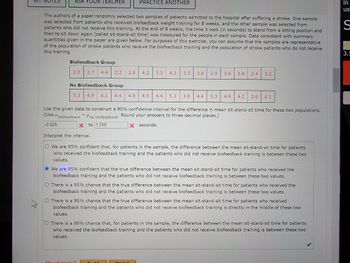
MATLAB: An Introduction with Applications
6th Edition
ISBN: 9781119256830
Author: Amos Gilat
Publisher: John Wiley & Sons Inc
expand_more
expand_more
format_list_bulleted
Question
help

Transcribed Image Text:ASK YOUR TEACHER
The authors of a paper randomly selected two samples of patients admitted to the hospital after suffering a stroke. One sample
was selected from patients who received biofeedback weight training for 8 weeks, and the other sample was selected from
patients who did not receive this training. At the end of 8 weeks, the time it took (in seconds) to stand from a sitting position and
then to sit down again (called sit-stand-sit time) was measured for the people in each sample. Data consistent with summary
quantities given in the paper are given below. For purposes of this exercise, you can assume that the samples are representative
of the population of stroke patients who receive the biofeedback training and the population of stroke patients who do not receive
this training.
Biofeedback Group
2.0 2.7 4.4
2.2
No Biofeedback Group
5.3 4.9 4.1
PRACTICE ANOTHER
Mec
4.4
2.8 4.2 3.3
4.9 4.5 4.4 5.3 3.6 4.4 5.3 4.6 4.2 3.6 4.1
Use the given data to construct a 95% confidence interval for the difference in mean sit-stand-sit time for these two populations.
(Use biofeedback - no biofeedback: Round your answers to three decimal places.)
-0.826
X to 1.748
X seconds
4.1 3.3 3.6 2.9 3.6 3.6 2.4 3.2
Interpret the interval.
O We are 95% confident that, for patients in the sample, the difference between the mean sit-stand-sit time for patients
who received the biofeedback training and the patients who did not receive biofeedback training is between these two
values.
We are 95% confident that the true difference between the mean sit-stand-sit time for patients who received the
biofeedback training and the patients who did not receive biofeedback training is between these two values.
O There is a 95% chance that the true difference between the mean sit-stand-sit time for patients who received the
biofeedback training and the patients who did not receive biofeedback training is between these two values.
O There is a 95% chance that the true difference between the mean sit-stand-sit time for patients who received
biofeedback training and the patients who did not receive biofeedback training is directly in the middle of these two
values.
O There is a 95% chance that, for patients in the sample, the difference between the mean sit-stand-sit time for patients
who received the biofeedback training and the patients who did not receive biofeedback training is between these two
values.
in
us
S
3.5
Expert Solution
This question has been solved!
Explore an expertly crafted, step-by-step solution for a thorough understanding of key concepts.
Step by stepSolved in 2 steps with 1 images

Knowledge Booster
Similar questions
arrow_back_ios
SEE MORE QUESTIONS
arrow_forward_ios
Recommended textbooks for you
 MATLAB: An Introduction with ApplicationsStatisticsISBN:9781119256830Author:Amos GilatPublisher:John Wiley & Sons Inc
MATLAB: An Introduction with ApplicationsStatisticsISBN:9781119256830Author:Amos GilatPublisher:John Wiley & Sons Inc Probability and Statistics for Engineering and th...StatisticsISBN:9781305251809Author:Jay L. DevorePublisher:Cengage Learning
Probability and Statistics for Engineering and th...StatisticsISBN:9781305251809Author:Jay L. DevorePublisher:Cengage Learning Statistics for The Behavioral Sciences (MindTap C...StatisticsISBN:9781305504912Author:Frederick J Gravetter, Larry B. WallnauPublisher:Cengage Learning
Statistics for The Behavioral Sciences (MindTap C...StatisticsISBN:9781305504912Author:Frederick J Gravetter, Larry B. WallnauPublisher:Cengage Learning Elementary Statistics: Picturing the World (7th E...StatisticsISBN:9780134683416Author:Ron Larson, Betsy FarberPublisher:PEARSON
Elementary Statistics: Picturing the World (7th E...StatisticsISBN:9780134683416Author:Ron Larson, Betsy FarberPublisher:PEARSON The Basic Practice of StatisticsStatisticsISBN:9781319042578Author:David S. Moore, William I. Notz, Michael A. FlignerPublisher:W. H. Freeman
The Basic Practice of StatisticsStatisticsISBN:9781319042578Author:David S. Moore, William I. Notz, Michael A. FlignerPublisher:W. H. Freeman Introduction to the Practice of StatisticsStatisticsISBN:9781319013387Author:David S. Moore, George P. McCabe, Bruce A. CraigPublisher:W. H. Freeman
Introduction to the Practice of StatisticsStatisticsISBN:9781319013387Author:David S. Moore, George P. McCabe, Bruce A. CraigPublisher:W. H. Freeman

MATLAB: An Introduction with Applications
Statistics
ISBN:9781119256830
Author:Amos Gilat
Publisher:John Wiley & Sons Inc

Probability and Statistics for Engineering and th...
Statistics
ISBN:9781305251809
Author:Jay L. Devore
Publisher:Cengage Learning

Statistics for The Behavioral Sciences (MindTap C...
Statistics
ISBN:9781305504912
Author:Frederick J Gravetter, Larry B. Wallnau
Publisher:Cengage Learning

Elementary Statistics: Picturing the World (7th E...
Statistics
ISBN:9780134683416
Author:Ron Larson, Betsy Farber
Publisher:PEARSON

The Basic Practice of Statistics
Statistics
ISBN:9781319042578
Author:David S. Moore, William I. Notz, Michael A. Fligner
Publisher:W. H. Freeman

Introduction to the Practice of Statistics
Statistics
ISBN:9781319013387
Author:David S. Moore, George P. McCabe, Bruce A. Craig
Publisher:W. H. Freeman